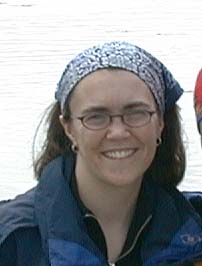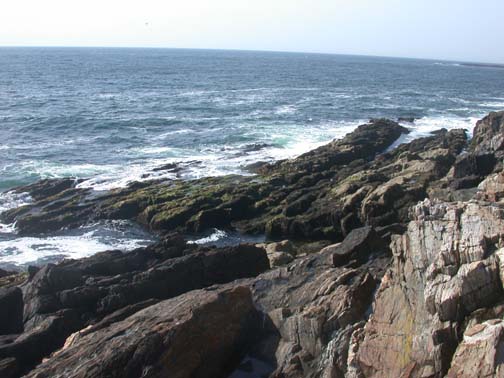

| I am currently an Adjunct Professor in Biology at Bowdoin College. For a nice summary of some of the work I am doing at Bowdoin, see the Article in the Bowdoin Sun |

|
In my current position at Bowdoin College, I am investigating an invasive species of bryozoan in the Gulf of Maine. Membranipora membranacea was first seen in the Gulf of Maine in 1987 at the Isle of Shoals and within two years became the dominant organism living on native seaweeds such as kelps. I am investigating (1) how Membranipora was able to spread so quickly and (2) what the consequences are of adding this new species to the Gulf of Maine ecosystem.
I am interested broadly in what structures the distribution and abundance of marine organisms. In the past I have focused on how shape and material properties affect seasonal dislodgement risk in intertidal seaweeds. For my Ph.D. dissertation I looked at how water velocity affects feeding, form, abundance, growth, and survival in bryozoans, colonial marine invertebrates.
I have recently become more involved with research on metabolism and growth
in marine invertebrates, especially sea stars. Sea
stars can play a very important role in structuring a community because they
are voracious predators. The two common species on rocky shores in Maine are
Asterias forbesi and Asterias
rubens (=vulgaris). Because the
environment changes so dramatically over the course of the year (e.g. water
temperatures can vary from 0-18°C), these sea stars must be able to acclimate
to a wide range of environmental conditions. Previous research suggests that
A. forbesi is more tolerant of warmer temperatures, while A. rubens
prefers colder temperatures. Historical records indicate that A. rubens
was more abundant along the Maine coast, but more recently A. forbesi
seems to becoming a more dominant species. I am measuring each species response
to temperature to determine if increasing environmental temperatures may be
contributing to the northern expansion of A. forbesi.
No matter what kind of career path I follow, I know for sure that I want to teach biology in some capacity. So far, I have had most of my teaching experience at the college level, but I have also had some involvement with K-12 education outreach programs. I enjoy teaching others how fascinating marine organisms are, and I hope I can inspire people to appreciate the marine environment so that they will want to protect it. I think one of the most important aspects of teaching science is to teach the process of doing science and how to evaluate the research of others. One of the most rewarding experiences I have had is the opportunity to mentor students in independent research. I find that the best way for a student to understand the scientific process is to to try it themselves. See my Statement of Teaching Philosophy for more details on my teaching experience and philosophy.
At Bowdoin College, I taught Intertidal Ecology in the Spring of 2004, Marine Physiological Ecology in the Fall of 2004, Coastal Marine Life in Spring 2005, Fall 2005, and Spring 2006, and Investigations in Biology in the Spring of 2005 and 2006.
I have also been involved in developing the curriculum for the Bowdoin College Coastal Science Institute For Middle School Science Educators. Bowdoin College offered a week long Summer Institute for middle school science teachers to help improve coastal and marine "literacy" in the sciences, and the theme in 2005 was invasive species. The program was a great success (see this article).
Classes I have taught have created websites as class projects, check them out:
Some Marine Research Stations
Teaching and Education Resources
Bryozoa
Sea stars
Last modified October 8, 2004